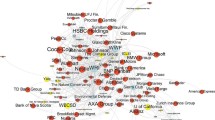Abstract
The paper introduces a generalized spatial model that is motivated by the frequent changes in party identity and electoral laws that characterize transitional party systems. In this model, parties may (1) change their platforms, (2) their identities through coalitions and splits and (3) if they form a winning coalition, the electoral law. The equilibrium is defined as a state such that no party or coalition can strictly benefit from changing the electoral law, its platform, or from splitting or coalescing. The results show that while there are games with no institutional or coalitional-split equilibria, such equilibria do exist under relatively undemanding conditions. The main finding is that once an institutional and identity equilibrium is achieved, it is generically robust against small trembles in party platforms or voter preferences. This robustness facilitates greater stability in terms of institutions and party identities in mature party systems where such trembles are smaller than in transitional systems.
Similar content being viewed by others
References
Austen-Smith D, Banks JS (1999) Positive political theory 1 Collective preference. The University of Michigan Press, Ann Arbor
Calvert RL (1986) Models of imperfect information in politics. Harwood Academic Publishers, Chur
Chwe M (1994) Farsighted coalitional stability. J Econ Theory 63:299–325
Coughlin P, Nitzan S (1981) Directional and local electoral equilibria with probabilistic voting. J Econ Theory 24:226–240
Coughlin P (1992) Probabilistic voting theory. Cambridge University Press, New York
Cox G (1987a) Electoral equilibrium under alternative voting institutions. Am J Polit Sci 31:82–108
Cox G (1987b) The uncovered set and the core. Am J Polit Sci 31:408–422
Cox GW (1990) Multicandidate spatial competition in advances in the spatial theory of voting. In: Enelow JM, Hinich MJ (eds) Cambridge University Press, Cambridge
Davis OA, DeGroot MH, Hinich MJ (1972) Social preference orderings and majority rule. Econometrica 40:147–157
Downs A (1957) An economic theory of democracy. Harper, New York
Eaton BC, Lipsey R (1975) The principle of minimum differentiation reconsidered: some new developments in the theory of spatial competition. Rev Econ Stud 42:27–50
Enelow JM, Hinich MJ (1984) The spatial theory of voting: an introduction. Cambridge University Press, Cambridge
Enelow JM, Hinich MJ (eds) (1990) Advances in the spatial theory of voting. Cambridge University Press, Cambridge
Ferejohn JA, McKelvey RD, Packel EW (1984) Limiting distributions for continuous state markov voting models. Social Choice Welf 1:45–67
Filippov MG, Ordeshook PC, Shvetsova OV (1999) Party fragmentation and presidential elections in post-communist democracies. Const Polit Econ 3–26
Geddes B (1996) Initiation of new democratic institutions in Eastern Europe and Latin America in Institutional Design in New Democracies. Eastern Europe and Latin America. In: Lijphart A, Waisman CH (eds) Westview Press, Boulder
Grofman B, Mikkel E, and Taagepera R (1999) Electoral systems change in Estonia, 1989–1993. J Baltic Stud 30:227–49
Grofman B, Mikkel E, Taagepera R (2000) Fission and fusion of parties in Estonia, 1987–1999. J Baltic Stud 31:329–357
Hinich MJ, Munger MC (1997) Analytical politics. Cambridge University Press, Cambridge
Kaminski MM (2001) Coalitional stability of multi-party systems: evidence from Poland. Am J Polit Sci 45:294–312
Kaminski MM (2002) Do parties benefit from electoral manipulation? Electoral laws and Heresthetics in Poland, 1989–1993. J Theoret Polit 14:325–359
Kaminski MM, Lissowski G, Swistak P (1998) The “revival of communism” or the effect of institutions? The 1993 Polish parliamentary elections. Public Choice 97:429–449
Kopecky P (1995) Factionalism in parliamentary parties in the Czech Republic: a concept and some empirical findings. Democratization 2:138–151
Kramer G (1973) On a class of equilibrium conditions for majority rule. Econometrica 41: 285–297
Lomax B (1995) Factions and factionalism in Hungary’s new party system. Democratization 2:125–137
McKelvey RD, Schofield NJ (1987) Generalized symmetry conditions at a core point. Econometrica 55:923–934
Miller N (1980) A new solution set for tournaments and majority voting. Am J Polit Sci 24:68–96
Miller NR (1995) Committees, agendas, and voting. Harwood Academic Publishers, Chur
Moraski B, Loewenberg G (1999) The effect of legal thresholds on the revival of former communist parties in East-Central Europe. J Polit 61: 151–170
Moser RG (2001) Unexpected outcomes. Electoral systems, political parties, and representation in Russia. University of Pittsburgh Press, Pittsburgh
Ordeshook PC (1986) Game theory and political theory. Cambridge University Press, Cambridge
Plott CW (1967) A notion of equilibrium and its possibility under majority rule. Am Econ Rev 57:787–806
Remington TF, Smith SS (1996) Political goals, institutional context, and the choice of an electoral system: the Russian parliamentary election law. Am J Polit Sci 40:1253–1279
Rosenthal RW (1972) Cooperative games in effectiveness form. J Econ Theory 5:88–101
Schofield NJ (1985) Social choice and democracy. Springer, Berlin Heidelberg Newyork
Schofield N (1993) Political competition and multiparty coalition governments. Eur J Polit Res 23:1–33
Schofield N, Sened I (1997) A general equilibrium approach to the study of multiparty electoral systems. Typesrcipt, Washington University in St. Louis
Shaked A (1975) Non-existence of equilibrium for the two-dimensional three-firms location problem. Rev Econ Stud 42:51–56
Shepsle KA (1979) Institutional arrangements and equilibrium in multidimensional voting models. Am J Polit Sci 23:27–60
Shepsle KA (1991) Models of multiparty electoral competition. Harwood Academic Publishers, London
Shepsle K, Weingast B (1981) Structure induced equilibrium and legislative choice. Public Choice 37:503–519
Waller M (1995) Making and breaking: factions in the process of party formation in Bulgaria. Democratization 2:152–167
Wyniki glosowania nr 75 - posiedzenie 103 (2001) Sejm: Warsaw: http://orka.sejm.pl
Wyniki symulacji (2001) in Rzeczpospolita 05/02: Warsaw
Zdort MD (1997) ROP z AWS o wyborach in Rzeczpospolita 06/11: Warszawa
Author information
Authors and Affiliations
Corresponding author
Rights and permissions
About this article
Cite this article
Kaminski, M.M. A General Equilibrium Model of Multi-Party Competition. Soc Choice Welfare 26, 333–361 (2006). https://doi.org/10.1007/s00355-006-0095-1
Received:
Accepted:
Published:
Issue Date:
DOI: https://doi.org/10.1007/s00355-006-0095-1



